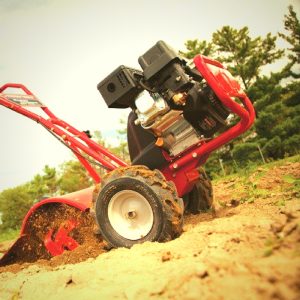
Tillers are workhorses that churn through soil, destroying weeds as they break up the ground. Tilling a garden saves the gardener backbreaking work. It would take hours or even days using a shovel to turn a medium garden plot.
Tillers do a consistently better job preparing gardens for planting. All models can be used to distribute compost or fertilizer. Smaller, slimmer front-tine models work best to keep weeds under control. Larger rear-tine models are capable of chewing through small tree roots and can plow large plots of ground in a short time. All power tillers have a depth bar adjuster so the operator can select how deep the tines dig.
![prepare your garden bed with a tiller]() What are Tines?
What are Tines?
Tines are the rotating steel blades on a garden tiller that break through the ground and turn the soil. There are significant differences between front-tine and rear-tine tiller models.
Front-tine tillers are designed with the rotating tines in front of the drive wheels and under the engine. Tillers with tines in the front are best suited for jobs where the ground is soft and easy to work, such as an old garden from last season.
Rear-tine tillers are designed with the rotating tines behind the drive wheels. These models generally have greater digging power. A metal safety shield covers the tines to protect the operator from flying dirt, rocks, and debris.
Learn what else it takes to have good soil in your garden, here
Does It Matter Which Direction the Tines Turn?
The tines of a front-tine tiller turn only in a forward direction and can actually pull the tiller along the top of hard ground instead of turning the dirt. Front-tine machines are thus more suitable for working very soft soil.
 Rear-tine machines operate with either counter-rotating tines (CRT) or standard rotating tines (SRT).
Rear-tine machines operate with either counter-rotating tines (CRT) or standard rotating tines (SRT).
- CRT … Counter rotating tines turn in the opposite direction of the drive wheels. By resisting the forward motion of the front wheels, the tines literally chew at hard ground, breaking up large chunks of soil. CRT models offer the best choice for large jobs and for making new gardens.
- SRT … Standard rotating tines turn in the same direction as the drive wheels. The design and heavy weight distribution allow SRT models to break up fairly hard ground. The same-direction rotation makes this model an excellent choice for mixing compost or fertilizer into the soil.
- CRT to SRT … Some tiller models allow the operator to switch tine rotation from one direction to the other, offering the best of CRT and SRT functions.
Be aware: Some companies refer to standard rotating tines in their rear-tine models as forward rotating tines, or FRT. This should not be confused with front-tine tillers.
Selecting Tillers that are Right for the Job
- Cultivators (mini-cultivators) … Available in manual, electric, and gas models, these tilling machines have tines in front and are great for weeding or periodically loosening soil between rows of flowers or vegetables. Lightweight and portable, some models even fold for easier storage.
- Small Power Tillers … Available in gas and electric models. Front and rear-tine tillers with minimal horsepower are handy for making small gardens or maintaining old gardens that already have loose soil. Small machines can also be used for weeding and aerating soil between rows of flowers or vegetables, provided the distance between rows is wide enough.
- Front-Tine Tillers … Not recommended for breaking new or hard ground. Front-tine tillers can be difficult to control when the going gets rough.
- Electric Tillers … While they may be quieter to run, electric powered tillers are more suitable to gardens with softer soil. Electrical outlets may not always be available where you want to work.
- Medium and Larger Rear-Tine Tillers … The more horses under the engine, the more power available. Heavy-duty tillers cut through hard soil and churn heavy clumps into loose dirt. These machines do the best job overall, including mixing nutrients into the soil and maintaining weed control. These models are easy to maneuver during operation once new ground is broken.
As shown on TV, many tillers can be operated with one hand in places where the soil is light and soft. It’s always wise to do a little research before investing a large sum of money in any new product. Test drive a few models before you buy to see which works best for you. Renting each a front-tine model and a rear-tine model is a good way to test the products on your home turf.
Tillers are great for the weekend garden enthusiast, as well as the serious landscaper. Organic gardeners rely on tillers to mix compost into the soil. Listen to what friends and neighbors have to say about tillers they own, but remember: Your neighbor’s needs may be different from yours, so take inventory of your own garden and landscaping requirements before deciding what model to buy.
The post Tillers, Turning Bare Ground into Gardens appeared first on All around the house.
from All around the house http://allaroundthe.house/tillers-turning-bare-ground-gardens/
via IFTTT
 What are Tines?
What are Tines?
Comments
Post a Comment